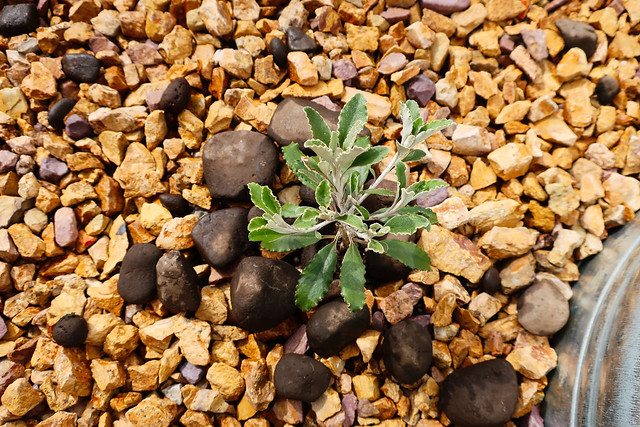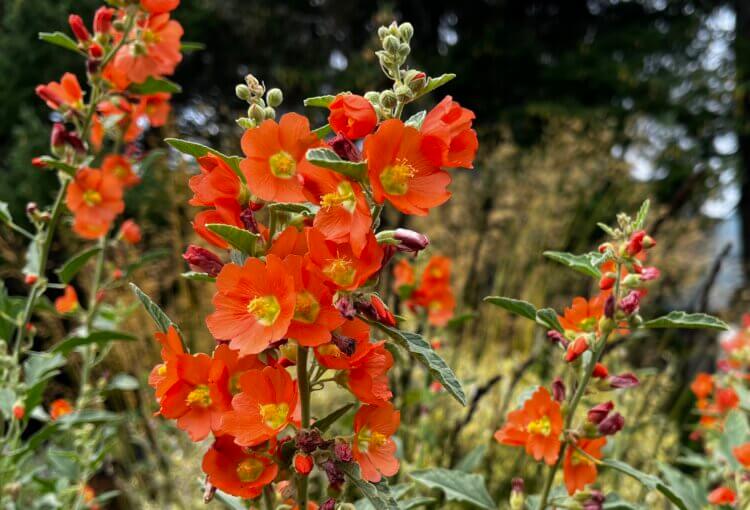Checking in on the Long Beach garden, it feels a little like cleaning up after a party that you weren’t invited to. In summer’s aftermath, it’s all about reading the seedpods and dessicated growth for clues of what vegetative frivolity transpired while I was away. (I last saw the garden in May 2025.)
Judging by the amount of dried bloom stalks to cut down, the anigozanthus had a good summer and bloomed well. Aloe lukeana had several dried bloom stalks. The horned poppy romped through the succulents, smothering them like party bunting in yards of foliage and dried seedheads. But once all the tumbleweeds of summer growth were cleared, the garden re-emerged as I remember it. This holding pattern is of course a relief but also a little bittersweet. It’s the day-to-day adjustments and experiments (and weeding!) that keep a garden fresh and exciting, only possible when living with it full time.
Multiple tree-like sonchus staged a takeover, and older woody specimens where thinned, leaving a few young rosettes. Other insistent reseeders included Manihot grahamii. The canopy of the manihot, a small tree, was cut but the 2″ trunk remains along with dozens of its progeny. Couch grass infests everything, and there’s days left of weeding to deal with it.
It’s a lot to ask any garden to manage on its own for six months, but once again I’m thrilled and relieved to find the garden holding itself together somehow.
The garden is scruffy and shaggy with sesleria, which needs raking, but one of this grass’ striking virtues is being able to withstand the infiltration of couch grass. Removing this weed winding through the base of the big aloes has been the trickiest job yet. Yards of dessicated, skeletonized stuff like African basil were pulled. Silvery-leaved Geranium harveyi, so beautiful when I left the garden in April, couldn’t handle the dry summer. But a vibrant dwarf copper canyon daisy, Tagetes lemonii, somehow continued to bloom despite the excessively dry conditions. Working near the daisy releases that offbeat pineappley scent, heavy with tropical resin notes.
Overall, though, it’s the herbaceous stuff that causes the most work, either from reseeding like the sonchus, manihot, Geranium maderense, euphorbias, Tinantia pringlei and Verbena bonariensis, or smothering summer growth, like the glaucium horned poppy. Still, a lot of issues were caused not by reseeders and weeds but by the growth of maturing plants.
A couple of large restios had to be moved and planted elsewhere, and the deferred decision was finally made to remove the dwarf “golfball” pittosporum, which was needing a lot of clipping to keep to 4×4′. A really good alternative to a box orb, I hated to sacrifice the pittosporum but couldn’t get enough root to move it.
A neighbor came by to water infrequently, which I think helped with the potted plants even if they were only spritzed superficially. The ground was bone-dry.
The drive south from Oregon was harrowing the first day, battered by an atmospheric river and relentlessly pounding winds. We took three days, two nights this time, and stayed the first night in Brookings, near the California/Oregon border. Driving through the little town, I wasn’t sure I could trust my eyes. Wasn’t that a tree aloe in someone’s garden? Salvia leucantha and a large Agave americana also whizzed by as we drove out of town. Checking the phone proved I wasn’t hallucinating. Brookings is considered the “banana belt” of Oregon coastal towns. Really cool working harbor too.
Rain predicted all weekend, what a godsend. More soon, AGO.
















































































































